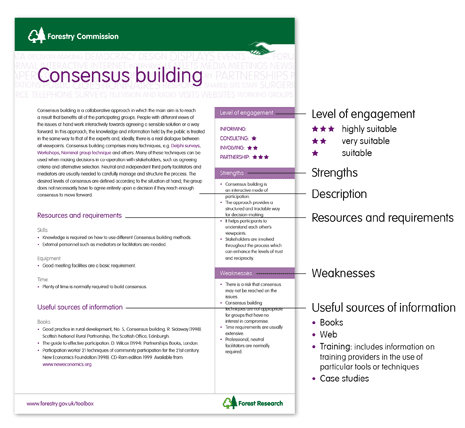This toolbox has been designed for use as a digital resource. The PDF includes hyperlinks to assist navigation to the most relevant tool or technique in the toolbox, and also to relevant external publications and websites.
The right tool for the job
The toolbox provides information on a wide variety of public involvement tools. All the tools have their particular strengths and weaknesses. Some are good ways of providing information to people; others are better ways of consulting with people; while others are better for allowing people directly to participate in making a decision. The most important thing to remember when selecting methods is that different tools will be best suited to different engagement objectives, different activities, and the different kinds of people and stakeholders you wish to include.
There are other questions you should ask yourself when considering the appropriate tool for the level of engagement:
The contents’ page provides you with three different tables to help you select the most appropriate tools when planning your public engagement:
The toolsheets
The toolbox consists of a collection of single ‘toolsheets’ that provide information on the public involvement tools that may be useful to you when working with a variety of people in developing forest or woodland plans. An example is shown below.
The toolsheets are not definitive but represent a summary of different tools gathered from a range of published sources in print and on the Internet. These sources were found to vary considerably in their descriptions of the same method, therefore we have tried to choose the ‘best-fit’ description for a forest or woodland planning situation. Sometimes the tools are known by other names – we have included these alternatives.
The nature of the tools and techniques means that they are used and adapted by people to meet their individual needs, and so they evolve with use. Some tools are therefore closely ‘related’ to others and some are ‘subsets’ of others. Being creative is encouraged! Adapt tools to suit your own circumstances. Tools can be modified and used in a variety of different ways.
We hope that these toolsheets will inspire you to try out a few previously unfamiliar tools. In doing so you will probably adapt and change the ideas they contain to meet your needs. This will in turn contribute to the evolutionary process and the creation of new public involvement tools that will be of value to others. We look forward to hearing about your experiences.

The toolbox is intended to give you practical assistance. Please let us know about any problems you encountered when using it, or ideas you may have, so that we can improve on our future guidance. Please let us know about: